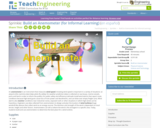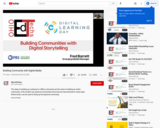
Students build anemometers and use them to calculate wind speed.
- Subject:
- Practitioner Support
- Material Type:
- Lesson Plan
- Provider:
- TeachEngineering
- Provider Set:
- TeachEngineering
- Date Added:
- 10/14/2015

Students build anemometers and use them to calculate wind speed.

Students build electromagnets and use them to pick up objects.

This class features the professional learning eBook, Building Blocks for Tiny Techies: A Teacher's Guide to Digital Learning in Primary Classrooms by Jamila "Mia" Leonard. Use this class as a guide for a book study that includes featured discussion questions, INFOhio resources, and instructional materials to support integration in the classroom.
In this book, the author shares her expertise with best practices for tech implementation, adaptation, and exploration in the elementary classroom, where today's students are digital natives, adept at using touchscreens and apps from an early age. She offers strategic, seamless, and intentional ways to fold tech into existing curricula. This guide helps teachers reach for apps and learning tools that power up the great learning that's already happening in the classroom.

The steps in building up a physical or offline community are the same in building an online community. In the modern era, physical communities have become disconnected in many ways. Online tactics can be used to bring up the physical community.
Staying connected is the basis of community development. Learn how to stay connected through facilitating conversations and providing information through social media, video and audio podcasts, blogs, newsletters, and other digital platforms. These digital content tools can provide additional avenues to keep the community engaged.
Live Q & A Doc:

Examine specific reasons for investing in powerful family and community partnerships which are important to the school and students within. Educators will determine the foundational components needed in my school (or classroom) to build strong family and community partnerships.
Approximate time to complete this course is 4 hours. A micro-credential is available from Digital Promise upon completion.

Eliminate data silos and explore data planning tools while promoting diversity of perspectives and encouraging collaboration. Teachers will examine collaborative structures that foster a healthy culture around data, data collection and the presentation of data to stakeholders. Teachers will define what a collaborative data culture looks like in their classrooms and in their schools.
Approximate time to complete this course is 3 hours. A micro-credential is available from Digital Promise upon completion.

Come and check out this awesome pre-reading resource. This site offers examples of simple word games you can play with kids to increase their ability to recognize and use letters and sounds. Try these games the next time you're in the car or on the go.

Fifth Grade Science curriculum used and maintained by the Utah Board of Education

Physical, Earth, and Life Science for fourth grade. Used and maintained by the Utah State Board of Education

Coding is quickly becoming one of the biggest buzz words in education. However, teaching students to code can be intimidating. Join us as we discuss techniques for teaching coding concepts such as cause and effect, logic, and problem solving. Then we’ll dive into the CS First Curriculum to explore activities, lesson plans, and more.

This Google Doc contains a list of decisions and guidance to consider along with a brainstormed list of resources teachers can utilize when developing multiple days of learning activities that students can complete on their own in case of district closure due to weather or illness.

Public media stations across California have banded together to package a comprehensive set of broadcast and digital resources for teachers, students, and families for at-home learning. Drawing on our most popular offerings to teachers and families this past spring we've built more educational resources for meaningful teaching and learning in distance and digital environments. These award-winning and teacher-tested resources include professional development to help teachers pivot to distance learning and standards-aligned lesson plans and educational media that keep students engaged and learning.

Welcome to CAMP TV-a day camp experience in your living room! An enthusiastic head counselor, played by Zachary Noah Piser, guides "campers" as they learn through play. Content partners include the New York Public Library, Lincoln Center for the Performing Arts, Bedtime Math, Wildlife Conservation Society, the Memphis Zoo, and more. Here you'll find resources and activities to help extend the learning in each episode. You can stream full episodes of Camp TV on-demand at the series website.

Students model a water catchment basin and survey water pathways to understand factors that affect water flow.

Career advising is "an integrated process that helps students understand how their personal interests, strengths, and values might predict satisfaction and success in school and related career fields, as well as how to tie these interests and strengths to academic and career goals" (Gordon, V.N. 2007). The framework in which career advising occurs is defined as Career Connections. The Career Connection Framework is designed to support students in the development of a vision and realistic plan for their futures - during K-12 and beyond through career advising.

Technology is ever-present and ever-changing. It affects our daily lives in many ways. The same can be said for technology careers. Many jobs that our students will do as an adult do not exist yet. Exploring the field of tech careers is important because there are so many aspects and avenues within the field. Some careers require several years of advanced training while others may take less time. The objective of this package is to expose students to different careers within the tech field and inspire them to explore tech careers that align with their goals and training preferences.

These curated resources can help Intervention Specialists, Parents, and Administrators with guiding students through the transition period while they are matriculating from the K-12 setting to College, Trade School, or the Work Force. The resources can be used to help meet IEP Goals and Objectives for students with disabilities.

This template offers a structure to create a "content package" for a specific subject area and grade level. A content package is a collection of educator-curated instructional materials to support a given educational standard and need. Click View Resource to explore the structure or Remix to make a copy for your own use.

In this episode on Building Resilient Ecosystems for Education, Dr. Caroline Levander, who views university campuses as places of passion and dynamism, will provide insight into her roles as a university leader and scholar, and discuss the nuts and bolts of building community in higher education. A new virtual interview series from LabXchange at Harvard University, The Xchange showcases the diverse roles, projects, and initiatives that make up the intersecting fields of science, education, and health. Hosted by LabXchange Faculty Director Robert Lue, our first season features a range of perspectives on the impact of COVID-19.

This article cites several studies and research that support testing students in early elementary school, starting in kindergarten. The research in the article shows that grades K-3 are critical in a child's development and that performance in kindergarten can predict future success in school. It also shows that testing can allow early intervention to help students who are struggling before they reach upper elementary school and beyond.